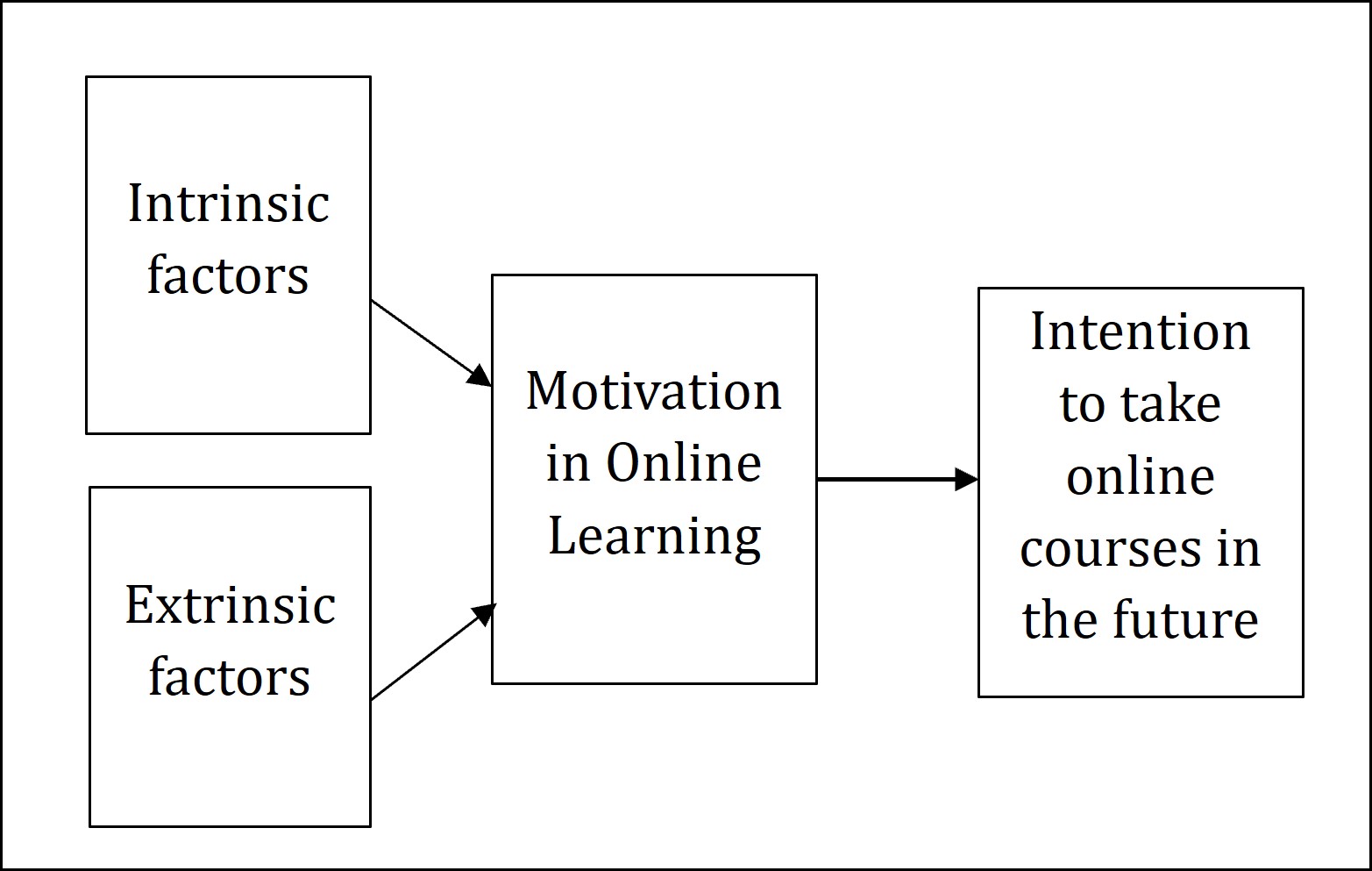Undergraduate students' motivation toward online learning and intention to enrol in future online courses
Main Article Content
Abstract
Online education has become increasingly common, particularly in higher education, and students' willingness to learn online has increased following the COVID-19 pandemic. This study aimed to understand the factors that motivate students to learn online and their intentions to continue taking online courses. The research surveyed 112 students from a private university in Malaysia and found that both intrinsic and extrinsic factors motivated them to learn online. The majority of students also intended to continue with online learning in the future. Extrinsic incentives such as performance improvement were found to be the most effective motivators. Universities should consider adjusting the curriculum to improve student learning while considering the flexibility of the time and effort that students should put in to build a meaningful online learning experience.
Article Details

This work is licensed under a Creative Commons Attribution-NonCommercial-NoDerivatives 4.0 International License.
References
Alfarimba, R., Ardianti, S. D., & Khamdun, K. (2021). The Impact of online learning on the learning motivation of primary school students. Progres Pendidikan, 2(2), 94–99.
Alhamami, M. (2018) Beliefs about and intention to learn a foreign language in face-to-face and online settings, Computer Assisted Language Learning, 31(1-2), 90-113, DOI: 10.1080/09588221.2017.1387154
Che Soh, M., Puteh, F., Mahmud, M. B., Abdul Rahim, M., Soegiono, A.G., & Rahmat, N.M. (2022). Investigating the source of motivation for online learning. International Journal of Academic Research in Business and Social Sciences, 12(1), 2189–2208.
Choi-Meng, L., Chin, F.G., Irene, K., Roy, C. and Hii, P.K. (2020). E-Learning continuance intention in Malaysia, Journal of Archeology of Egypt, 17(10), 523–535.
Cole, M. T., Shelley, D. J., & Swartz, L. B. (2014). Online instruction, e-learning, and student satisfaction: A three-year study. The International Review of Research in Open and Distributed Learning, 15(6), 111–131.
Dumford, A. D., & Miller, A. L. (2018). Online learning in higher education: Exploring advantages and disadvantages for engagement. Journal of Computing in Higher Education, 30(3), 452–465. https://doi.org/10.1007/s12528-018-9179-z.
Fitriyani, Y., Fauzi, I., & Sari, M. Z. (2020). Motivasi belajar mahasiswa pada pembelajaran daring selama pandemik Covid-19. Jurnal Kependidikan: Jurnal Hasil Penelitian dan Kajian Kepustakaan di Bidang Pendidikan, Pengajaran dan Pembelajaran, 6(2), 165–175.
Gustiani, S. (2020). Students’ motivation in online learning during Covid-19 pandemic era: A case study. Holistics, 12(2), 23–40.
Harandi, S. R. (2015). Effects of E-learning on students’ motivation. Procedia-Social and Behavioral Sciences, 181(2015), 423–430.
Hussein, L. A., & Hilmi, M. F. (2022). Intention to continue using online learning among Malaysian university students. Asian Journal of University Education (AJUE), 18(4), 997–1009.
Luo, Y., Lin, J., & Yang, Y. (2021). Students’ motivation and continued intention with online self-regulated learning: A self-determination theory perspective. Zeitschrift für Erziehungswissenschaft, 24(6), 1379–1399.
Marandu, E. E., Mathew, I. R., Svotwa, T. D., Machera, R. P., & Jaiyeoba, O. (2022). Predicting students' intention to continue online learning post-COVID-19 pandemic: extension of the unified theory of acceptance and usage technology. Journal of Applied Research in Higher Education, (ahead-of-print).
Mardesci, H. (2020). The effect of online learning on university students’ learning motivation. Online Learn, 1(5), X6–47.
Mese, E. & Sevilen, C. (2021). Factors influencing EFL students’ motivation in online learning: A qualitative case study, Journal of Educational Technology & Online Learning, 4(1), 11–22.
Minda, S. (2020). Online-learning and students’ motivation: A research study on the effect of online learning on students’ motivation in IAIN Padangsidimpuan. In International Online Conference on English and Education, 1(1), 87–101.
Motevalli, S., Perveen, A., & Michael, M. T. A. (2020). Motivating students to learn: An overview of literature in educational psychology. International Journal of Academic Research in Progressive Education & Development, 9(3), 63–74. http://dx.doi.org/10.6007/IJARPED/v9-i3/7779
National Centre for Education Statistics. (2022). Postbaccalaureate Enrollment. Condition of Education. U.S. Department of Education, Institute of Education Sciences. https://nces.ed.gov/programs/coe/indicator/chb.
Panigrahi, R., Srivastava, P.R. and Sharma, D. (2018). Online learning: adoption, continuance and learning outcome. A review of literature. International Journal of Information Management, 43(2018), 1–14.
Ryan, R.M., & Deci, E.L. (2000a). Intrinsic and extrinsic motivations: Classic definitions and new directions. Contemporary Educational Psychology, 25(1), 54–67.
Ryan, R.M., & Deci, E.L. (2000b). Self-determination theory and the facilitation of intrinsic motivation, social development, and well-being. American Psychologist, 55(1), 68–78.
Ryan, R.M., & Deci, E. L. (2020). Intrinsic and extrinsic motivation from a self-determination theory perspective: definitions, theory, practices, and future directions. Contemporary Educational Psychology, 61(April), 1–11. https://doi.org/10.1016/j.cedpsych.2019.101831.
Simamora, R.M. (2020). The Challenges of online learning during the COVID-19 Pandemic: An essay analysis of performing arts education students. Journal of Studies in Learning and Teaching, 1(2), 86–103.
Sorebo, O, Halvari, H., Gulli, V.F., & Kristiansen, R. (2009). The role of self-determination theory in explaining teachers’ motivation to continue to use e-learning technology. Computers & Education, 53(4), 1177–1187. https://doi.org/10.1016/j.compedu.2009.06.001.
Sukendroa, S., Habibi, A., Khaeruddin, K., Indrayana, B., Syahruddin, S., Makadada, F. A., & Hakim, H. (2020). Using an extended Technology Acceptance Model to understand students’ use of e-learning during COVID-19: Indonesian sport science education context. Heliyon, 6 (11), 1–9. https://doi.org/10.1016/j.heliyon.2020.e05410.
Vululleh, P. (2018). Determinants of students’ e-learning acceptance in developing countries: An approach based on Structural Equation Modeling (SEM). International Journal of Education and Development using Information and Communication Technology (IJEDICT), 14(1), 141–151.
Wang, C.-H., Shannon, D.M., & Ross, M. E. (2013). Students’ characteristics, self-regulated learning, technology self-efficacy, and course outcomes in online learning. Distance Education, 34(3), 302–323. https://doi.org/10.1080/01587919.2013.835779.
Zhu, Y., Zhang, J. H., Au, W., & Yates, G. (2020). University students’ online learning attitudes and continuous intention to undertake online courses: A self-regulated learning perspective. Educational technology research and development, 68(3), 1485–1519.

